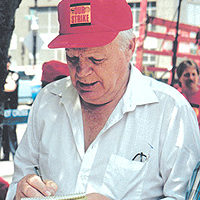The first storm of the season brought more than snow and cold to the thousands of homeless people in New York City. It also brought death to George Dalton, a homeless man who froze to death the night of Jan. 3 while sleeping under a highway overpass. Dalton was 64 and a Vietnam veteran. Across the Hudson River, in Jersey City, a man in his 60s was found frozen to death in a parking lot Jan. 6. Police believe he came from New York City.
According to Patrick Markee, there are three reasons for the increase in the city’s homeless population: “First was the economic slowdown. That was bad enough but everything was made worse by the events of Sept. 11, where thousands of low-paying jobs were destroyed. And third, the welfare reform of 1996, with its five-year limit on eligibility for public assistance, is forcing thousands of women and their families into living on the streets.”
Markee, senior policy analyst for the New York Coalition for the Homeless, said the official count of those living in shelters now stands at more than 30,000. He said he expects the situation to worsen as the weather grows colder and the economy continues its downhill slide.
Bill Davis, a retired social service worker and a member of State, County and Municipal Workers Local 371 who worked in a city shelter for 14 years, said many homeless men refuse to go into the shelters, partly because the facilities are dirty and partly out of fear for their safety.
The shelters “are not as dangerous as many people say but they are not as safe as they should be.” Davis said he questions the proposal of new Mayor Michael Bloomberg to station a police officer at the door of each city shelter. “They may scare off a person who fears arrest for some minor outstanding offense like jumping a turnstile in a subway station.”
The situation is much the same in Chicago, where five homeless people died in a cold snap that began a few days before New Year’s. John Donahue, director of the Chicago Coalition for the Homeless, told the World there has been a 35-percent increase in the city’s homeless population, primarily because the housing authority is wrecking public housing.
“At least 50,000 people have been displaced by the destruction of more than 20,000 units of public housing. The average age of the homeless population is nine years,” he added.
According to Michael Snoops, a community activist at the National Coalition for the Homeless, 1.9 million people – 25 percent of them children – seek shelter on any given night, with some 3.5 million individuals cycling through the ranks of the homeless during the year.
“Families, most of them women who have been forced off the welfare rolls, make up 52 percent of the country’s homeless army,” Snoops said. He added that 39 percent of homeless individuals were being turned away from shelters.
That figure is even worse for families, he said, “There, more than half are turned away.” According to Snoops, a fifth of homeless people have jobs but not enough money to pay rent.
All of those interviewed for this article agreed that the solution of the problem of homelessness was connected with dealing with what John Donahue, director of the Chicago Homeless Coalition, called “societal deficits”: the lack of a living wage, adequate health care and affordable housing.
Donahue called for a public works program to build affordable housing. “We could take $5 billion of the surplus of the Federal Housing Authority and invest it in a housing program for low-income people. We’d not only build needed housing, we’d create more than 180,000 jobs.”
The U.S. Conference of Mayors released the results of a survey of 27 cities Dec. 12. Among its findings were that requests for emergency shelter assistance increased by an average 13 percent in 2001 while available shelter beds increased by only nine percent.
The survey found that single men make up 40 percent of the homeless population, families with children 40 percent and single women 14 percent. Fifty percent are African American, 35 percent are white and 12 percent are Latino. Twenty percent of the homeless are employed and 11 percent are veterans.









Comments